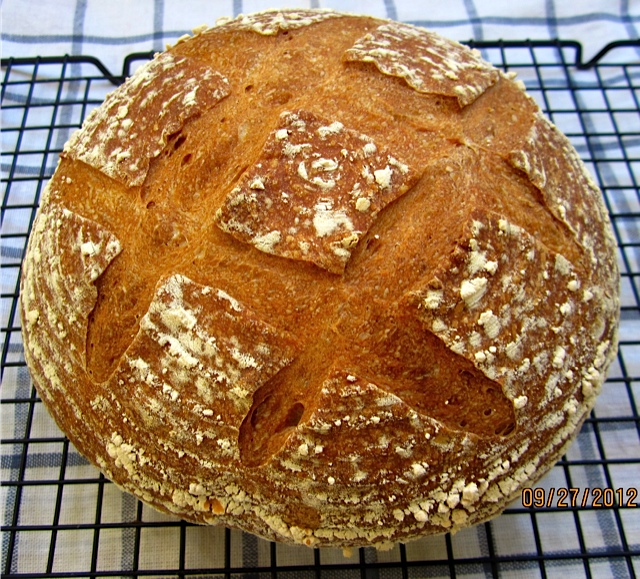
When I made my wonderful rose hip jam a month ago, temperatures were in the eighties, t-shirt weather for weeks, and we even used the air condition in our bedroom - in Maine!
The glasses were sitting on the kitchen counter, waiting to be properly tagged before going into the basement. But my husband, immobilized by a broken foot, needed special attention, and, between baking twice a week for our local natural food store, answering student questions online, and taking care of our undeserving critters, I didn't get to it for quite a while.
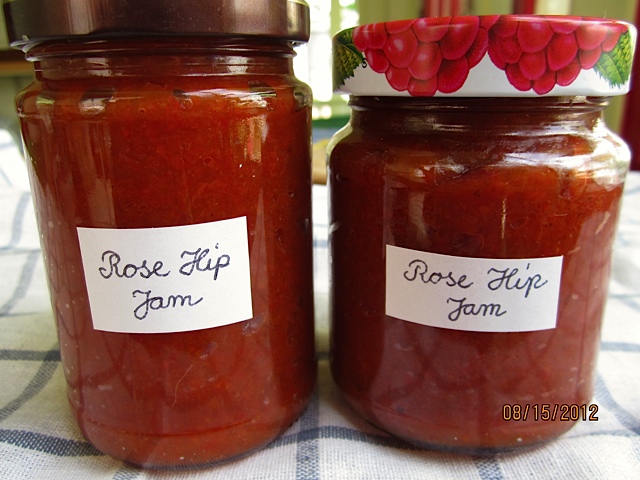
After a week or so, I noticed that one of the glasses showed ominous signs of frothy activity. Obviously I didn't fill it quite high enough to establish a vacuum, and, with the prevailing heat as incubator, my rose hip jam had started to ferment.
I was pretty annoyed with myself. Why didn't I pay more attention, and place the compromised glass into the fridge, before it could turn itself into booze?
No help for it, this was a goner, and had to be thrown out..... Or not? Suddenly I remembered my experiences with apple yeast water two years ago. Made from fermenting apples, the yeast water had proved to be a powerful leaven, my bread even grew a horn!
But in the end the apple yeast water died a slow death from starvation in a dark corner of my fridge, all but forgotten, since we preferred the tangier taste of sourdough.
Wouldn't it be worth a try to experiment a bit, and see what would happen if I fed the tipsy jam with flour?
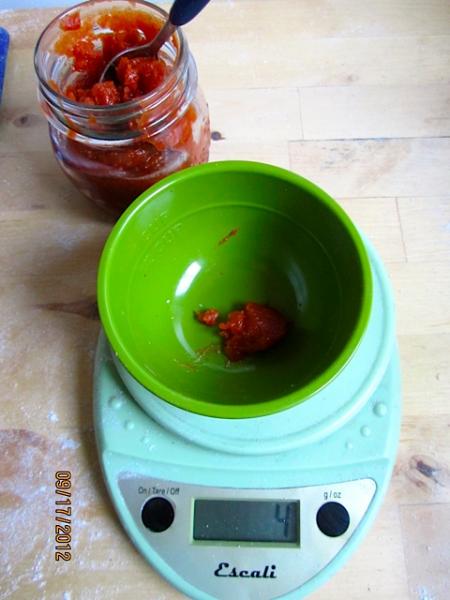
I measured a teaspoon of jam in a little bowl and added equal amounts of water....

....and whole wheat flour to the bowl:

5 g fermented rose hip jam + 25 g water + 25 g whole wheat flour.
Eleven hours later the reddish mixture had become bubbly and spongy, and emitted a wonderful fruity-sour smell.

I fed it two times more, aways with 25 g flour and 25 g water. It ripened faster each time, first after 3, then even only after 2 1/2 hours.
 Fully developed rose hip mother
Fully developed rose hip mother
I was very pleased and contemplated my next move.
I wanted to make a fairly simple levain, with a bit of whole grain, but not too much. I expected a rather mild taste, but I didn't want the blandness of an all-white bread, nor a too hearty loaf that overwhelmed more subtle nuances.
So I adapted a recipe for Pain au Levain, made with apple yeast leaven, from Jan Hedh's "Swedish Breads and Pastries". I had made this bread before, with apple yeast water, it had been nice, but rather mild.
Hedh's book is gorgeous, with wonderful recipes, though not without some pesky errata - my first attempt of an attractive looking Levain with Bran and Vinegar had ended in a dense, compact brick - thanks to one erroneous Zero too many in the bran department.
Even though it was already evening, I didn't want to wait, and started with 16 g of my newborn rose hip mother - mother, chef and levain are the classic French terms for the 3 steps to make a leaven - to make the second stage: the chef.
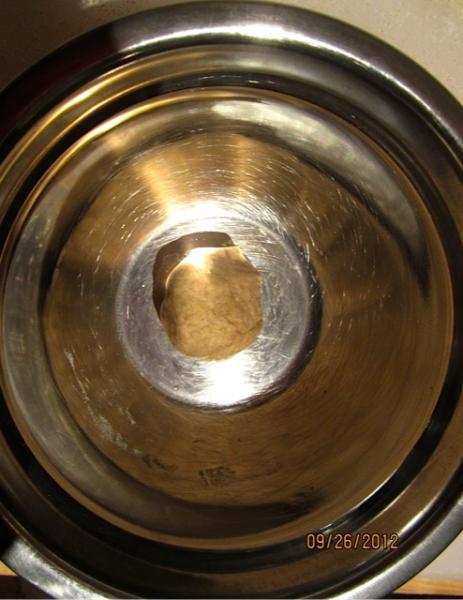 Chef after kneading
Chef after kneading
I woke up at midnight, went downstairs, eager to see how my starter was doing, and found a nicely grown chef, wide awake, and hungry for more.
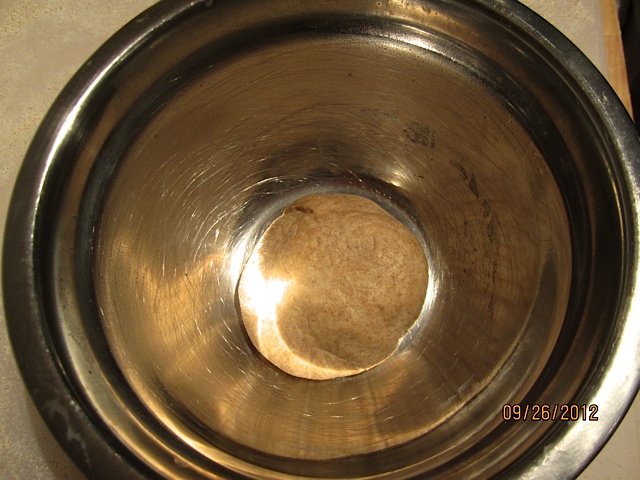 Fully developed chef
Fully developed chef
After feeding the little guy with more flour and water, I tottered back to bed. The next morning my levain was fully ripened and ready to go!
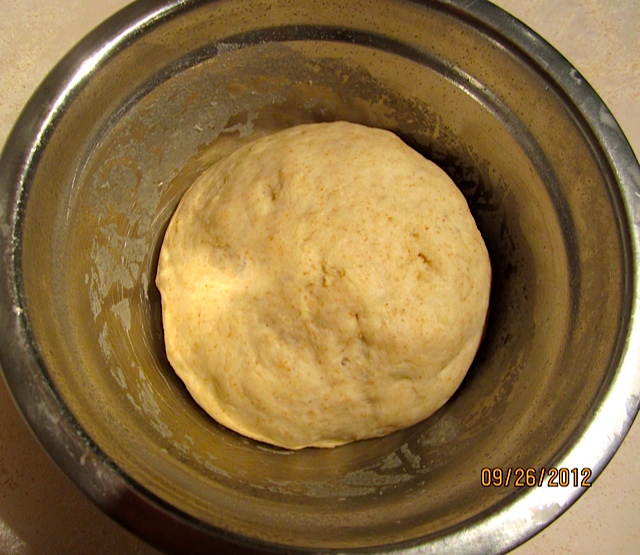 Fully developed rose hip levain
Fully developed rose hip levain
PAIN AU LEVAIN (adapted from Jan Hedh: "Swedish Breads and Pastries")
CHEF
21 g mother starter (it doesn't have to be rose hip, an ordinary mature wheat or rye starter will do)
8 g water
21 g bread flour
LEVAIN
50 g chef (all)
50 g water
100 g bread flour
FINAL DOUGH
200 g levain (all)
16 g spelt flour
16 g rye meal
282 g bread flour
219 g water
6 g salt
DAY 1:
1. Mix together all ingredients for chef. Knead for 2 minutes, then let rest for 5 minutes. Resume kneading for 1 more minute. (Dough should be stiff, but not hard, moisten your hands to incorporate more water, if needed.) Cover, and let sit for 4 hours, or until doubled in size.
2. Mix together all ingredients for levain. Knead for 2 minutes, then let rest for 5 minutes. Resume kneading for 1 minute more. (Dough should be stiff, but not hard, moisten your hands to incorporate more water, if needed.) Cover, and let ripen for 5 - 6 hours, or until doubled in size. Knead briefly to degas, and refrigerate overnight.
DAY 2:
3. Remove levain from refrigerator 2 hours before using, to warm up. Cut into smaller pieces and place with flour and water in mixer bowl. Knead for 3 minutes at low speed, then let dough rest for 5 minutes.
4. Add salt and continue kneading for 7 more minutes at medium-low speed. Stretch and fold 1 x, gather dough into a ball, place it in lightly oiled bowl, turn it around to coat with oil, cover, and let rest for 90 minutes.
5. Transfer dough to lightly floured work surface, place hands in the middle and push out the air, stretch and fold 1 x, gather dough into a ball, return it to the bowl, and leave it for another 80 minutes.
6. Push out air again, and let dough relax for 10 more minutes. Shape into a round, place in banneton (seam side up), or on parchment lined baking sheet (seam side down).
7. Sprinkle bread with flour, mist with baking spray, cover, and proof for 60 - 90 minutes (in a warm place), until it has grown 1 3/4 times its original size.
8. Preheat oven to 250º C/482º F, including steam pan. Score bread.
9. Bake bread for 5 minutes, reduce heat to 200º C/400º F, and continue baking for another 15 minutes. Rotate bread 180 degrees, remove steam pan, and bake for 20 minutes more, venting the oven once to let out steam in between.
10. Leave bread in switched-off oven with door slightly ajar for another 10 minutes. Transfer to wire rack and let cool completely.
 Rose Hip Levain crumb
Rose Hip Levain crumb
I changed Jan Hedh's recipe a bit. Instead of long kneading, I added a period of rest (autolyse) while mixing the dough, thereby shaving off some hands-on time.
A total baking time of 60 minutes, as stated in the recipe, was not necessary, my bread was already done after 40 minutes. And leaving it a while longer in the switched-off oven with the door a bit ajar guaranteed a nice crisp crust that didn't soften soon after baking.
Did it taste like rose hips? No. But is was delicious! And not only that: The best of all husbands found it "the crustiest bread you ever made".
One question remains: what was it exactly that gave the bread its marvelous lift? The rose hips? The apples? Or the red wine the jam was made with?
 Bar Harbor Shore Path - where Rugosa roses grow in abundance
Bar Harbor Shore Path - where Rugosa roses grow in abundance- hanseata's Blog
- Log in or register to post comments
I love it. Would you mind if I featured this on the front page for a bit?
-Floyd
Wow! What a great post. That is a great idea you had to turn adversity into triumph. Great story and terrific looking final bread.
Regards,
Ian
Of course, Floyd. That's very flattering!
Karin
My husband said I was grinning like the Cheshire Cat, when I presented the bread to him. I'm still amazed that it worked so well.
In the meantime I baked another bread with this funky starter, another go at Hedh's Pain au Levain with Bran and Vinegar. Though that recipe has some serious errata, the bread turned out quite well, too. (I will post an update.)
Karin
Pain au Levain with Bran and Vinegar
What a great looking bread! Is that a clover stamp you used or a coat of arms?
Great results, Karin! How inspiring!
I smiled at the midnight wake up to check on the dough :) quite typical of us home bakers..
The bread looks very delicious! with such extended fermentation, this bread is bound to be tasty, But In your hands, it is fabulous! The crumb texture is superb. The crust is lovely!
tale and idea. I just took out some of the new crop prickly pear tuna jam from the fridge and put it out uncovered on the counter.
That crumb of yours looks awfully like one YW would produce too. I've told my apprentice that if the tuna jam starts bubbling, she is not to forget to put hemp seeds in the bread we make from it :-) We love the rye and spelt additions - they must really boost the flavor.
Very nice baking Karin.
Ian, I tried to copy Jan Hedh's very pretty wine leaf decoration. I don't know how he did it - it had very sharp contours, mine are more blurred.
Karin
Did you cut out the dough and "glue' it on or use a cutter on the main dough?
I rolled out a piece of the dough and then used a knife to cut it out as good as I could. Then I brushed the boule with water and "glued" the leaf on it.
I don't know what the photo looked like, but yours looks great to me!
Nice job.
Yes, Khalid, you wake up, start thinking of it, and then can't go back to sleep.
Might as well get up and check...
The praise of a master is, of course, always very welcome!
Karin
I've only been baking for 3.5 years now, Karin. Master is a big word.
Dabrownman, what is that, a jam with TUNA?
If that starts fermenting, I can give you a recipe for a bread made with sepia ink, I bet a tuna levain would go well with it!
Fondly,
Karin
for hemp seeds, it doesn't surprise me that your hippy , hipster or at least hip side would eventually come out in, or after, one jam or another. The hip, hep or haw as my granny used to call them, is the fruit of the rose and can be delicious, a huge vitamin C source (19.32 times more than oranges pound for pound) and help in iron absorption if the side effects don't bother you.
Vomiting, diarrhea and nausea are common ones as are respiratory allergic reactions. Diabetics need to beware as hips can cause instability of sugar levels in the blood and interactions with medications for diabetes. Those with iron deficiencies and are on medications for it can also be adversely affected with unusual increases in iron absorption that can lead to kidney stones and increase other ailments associated with high iron absorption.
Tuna, on the other hand, is the fruit of prickly pear cactus. The only side effects known for tunas are a slight growth of webbing between the fingers and toes, growth of fins in unusual places too numerous to mention and in some cases, large gills develop on the throat, neck or arm pits :-)
Here is a picture of some tuna jam.
Some of it we use to make a PP Tuna simple syrup for margaritas
So why is it called "tuna"? Certainly not the color!
¿Cómo se llaman las frutas nopal en español? Tuna!
The fruits of plants is Spanish are called tunas. Thes fruits are also called catus figs, cactus apples, cactus fruit, Indian figs and who knows what else in English but in Spanish they are just plain old tuna.
is called atun, in Spanish. At least that's what the signs on the packing houses in Ensenada said.
Paul
Atun in Spanish is tuna in English. Much easier than humming a tune for me. Pretty soon Ian will have his loaves humming, probably in Spanish, a tune rather than singing when they come out of the oven :-)
I've never seen fruits like that.
And thanks for the encouraging information about rose hip side effects, Dabrownman (I now hope you grow those gills!)
Karin
worry about the side effects if you are healthy, no diabetes or iron problems and on medications for them and not allergic. If iron deficient and not on meds for it then rose hips can really help out. Granny Doerschlaht (good German stock) lived to be 94. She made and ate rose hip jam every year and was never iron deficient. It has its own unique taste -as tuna jam does.
You may not be able to find tunas in Maine but when you go to Mexico when it is freesing cold there, you can find them in the markets. They sell them in the the Mexican markets here in AZ. Lots of black, horribly hard seeds to get rid of though - making the jam harder to make than usual. The simple syrup is actually made from the sieved out seeds from jam making.
Alas, I was hoping the hemp and chia seeds would help ward off possible gill formation from tuna jam. Now I think I'm getting a new growth green hair replacing the gray - and is smells like patchouli !
:) :) :)
Karin
Can I get Patchouli oil in my town? I live in Patchogue :)
Looks delicious! Wish I could pull it out from my computer screen and eat it all up. :)
Thank you for your clear directions about using yeast water starter. Both breads look great. Looking forward to your update about the bran leaven. The book is so beautiful, but the errata is driving me crazy. The one I've tried a few times is the 'Seed Bread' on page 130. I think there is way too much water in Day 2 and that the salt and honey amounts must be switched. Thanks for all the pictures, too.
It sure tastes good, Bakingbadly (oh, that name - roll eyes).
Virtus, it's definitely worth a try with the yeast water - if you can't lay your hands on some fermented jam.
The errata really suck. There is all that ado about Hamelman's. Leader's or the "Inside the Jewish Bakery" errata, but nowhere exists a list with Hedh's. I haven't tried the "Seed Bread", yet. Just looking at the recipe, I think the salt and honey amounts might be actually right, because in dark German rye breads is usually quite a bit of salt, but they are less sweet than American ones.
The Pain au Levain (page 43) and the Pain de Campagne (page 51), and the Miche (page 75) are okay, the others, except for the errata ridden Levain with bran and vinegar I haven't tried, yet.
Karin
it takes more effort to put them through a strainer, and you might not have much pulp. But there is no reason why this shouldn't taste good, and it will be jam, not jelly. When I make the jam again next year, I will probably try using less or no extra pectin (apart from the apples) at all.
I will be traveling to Mexico in December, and I will sure look out for tunas.
Karin
WOW, Karing that is absolutely awesome...well done.
Speaking of Jam, did your rose hip jam develop any mold on the surface or you just notice a development of froth?
Another question:
I have been struggling to create a new sourdough starter after my old one died beyond any resurrection, as usual i made the newly attempted starter with equal parts of water and flour, day one: nothing happened (as expected), but surprisingly day two: lots of bubbles in the mix and on the surface, i stirred the whole thing, till day three: the mix almost trippled in volume, i stirred again and let it for next day. Then here's what happened: it went completely liquidy as if i had added more water to it without any flour, it smelt like fish (normal thing), i mixed it, but nothing happened. I discarded of half of it, and added some flour without water to give it some nutrition, still nothing happened. It looks liquidy, smells like fish, and without any sign of activity whatsoever.
What are your recommendations? Do you think i did something wrong here? Or do you think i should start a new one, or keep trying with this one?
Thanks,
Mike
Thanks, Mike, the jam just started getting frothy and smelling sour, there was no mold (otherwise I would have discarded it right away).
From what you describe I think your starter started fermenting, and then used up all the flour, and went limp. After feeding it with more flour, I would just give it more time, hopefully it revives.
I made my original starter with a higher flour to water ratio - 2 : 1. Here is how I did it the first time, and a few times more, when I accidentally used all of it. It always worked like a charm. Others use grapes or pineapple juice, you will find several methods here in TFL.
Karin
Thanks Karin for your reply. Comparing what happened to my new starter to yours or the description here i can confirm that my new starter is officially dead beyond repair. The reason is: though i added more flour to it yesterday (without any water) in a desperate try to balance what seemed to be excess water in it, but unfortunately today it looked as watery and runny as it was yesterday. So i discarded of the whole thing and started a new one today.
Looking at the link you sent me, they say adding flour to water in ratio of 2:1 which means providing more nutrition to bacteria than the ratio of 1:1 that i usually use. I guess it worth the try. But don't you think that this could make the starter extra acitic and more sour than the 1:1 sort of starter? I understand that you use this way 2:1 flour:water, right?!!
A new starter is not very tangy, it takes quite a while for it to develop a distinct taste. When I made my first starter, I baked only one bread a week, and always kept about 3/4 cup of the bread dough (after the first rise) in the fridge for the next loaf. Even then it took a while to taste more sour.
Once you get your new starter really going, you can tweak it to create a tangier or less sour bread with it. If you feed your dough often, it's less sour. If you use white flour it's less sour than whole wheat and rye makes the tangiest starter. The longer you keep a starter in the fridge without feeding it, the sourer it gets.
But at first the main consideration is to establish it, and that takes a while. A flour-water ratio of 2 : 1 is sturdier than a 100% hydration starter, it takes much longer for it to overferment.
Happy baking,
Karin